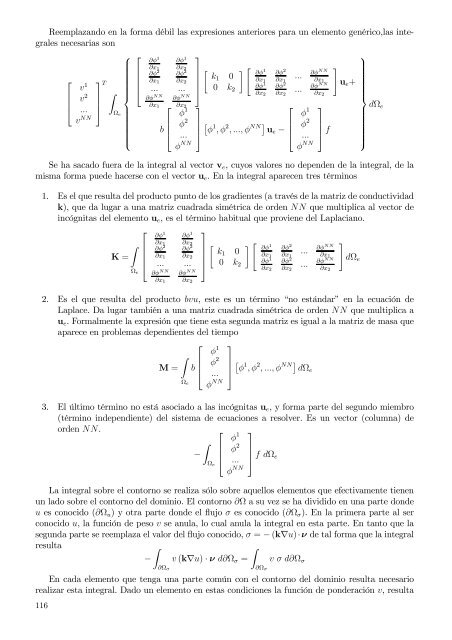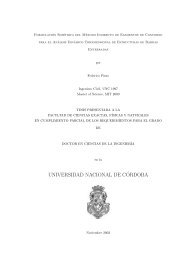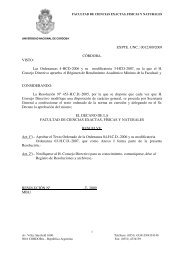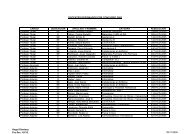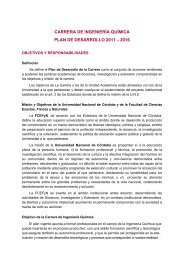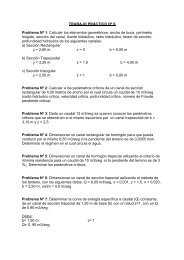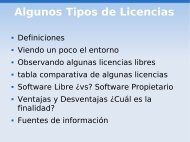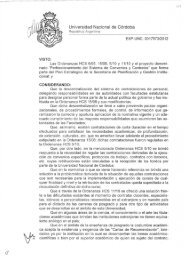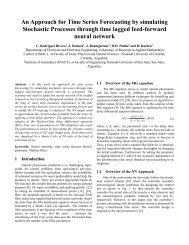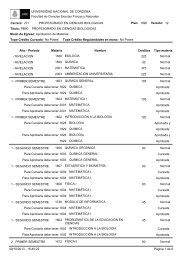Capítulo 1 Métodos de residuos ponderados Funciones de prueba ...
Capítulo 1 Métodos de residuos ponderados Funciones de prueba ...
Capítulo 1 Métodos de residuos ponderados Funciones de prueba ...
Create successful ePaper yourself
Turn your PDF publications into a flip-book with our unique Google optimized e-Paper software.
Reemplazando en la forma débil las expresiones anteriores para un elemento genérico,las integrales<br />
necesarias son<br />
⎡<br />
⎤<br />
∂φ<br />
⎡ ⎤<br />
v 1 T<br />
∫<br />
⎧⎪ 1 ∂φ 1<br />
∂x 1 ∂x ∂φ 2 ∂φ 2<br />
[ ] [ ]<br />
∂φ<br />
⎢<br />
∂x 1 ∂x 2<br />
k1 0<br />
1 ∂φ 2 ∂φ<br />
∂x<br />
⎥<br />
∂x 1<br />
...<br />
NN<br />
∂x 1<br />
u<br />
⎣ ... ... ⎦ 0 k ∂φ 1 ∂φ 2 ∂φ 2 ⎢ v 2<br />
⎨<br />
∂φ<br />
⎥<br />
NN ∂φ NN<br />
∂x 2 ∂x 2<br />
...<br />
NN e +<br />
∂x 2<br />
⎫⎪ ⎬<br />
∂x<br />
⎣ ... ⎦<br />
1 ⎡ ∂x 2 ⎤<br />
⎡ ⎤ dΩ e<br />
v NN<br />
Ω e φ 1<br />
φ 1<br />
b ⎢ φ 2<br />
[<br />
⎥<br />
⎪<br />
⎣ ... ⎦ φ 1 , φ 2 , ..., φ NN] u e − ⎢ φ 2<br />
⎥<br />
⎣ ... ⎦ f<br />
⎩ ⎪ ⎭<br />
φ NN<br />
φ NN<br />
Se ha sacado fuera <strong>de</strong> la integral al vector v e , cuyos valores no <strong>de</strong>pen<strong>de</strong>n <strong>de</strong> la integral, <strong>de</strong> la<br />
misma forma pue<strong>de</strong> hacerse con el vector u e . En la integral aparecen tres términos<br />
1. Es el que resulta <strong>de</strong>l producto punto <strong>de</strong> los gradientes (a través <strong>de</strong> la matriz <strong>de</strong> conductividad<br />
k), que da lugar a una matriz cuadrada simétrica <strong>de</strong> or<strong>de</strong>n NN que multiplica al vector <strong>de</strong><br />
incógnitas <strong>de</strong>l elemento u e , es el término habitual que proviene <strong>de</strong>l Laplaciano.<br />
⎤<br />
∫<br />
K =<br />
⎡<br />
⎢<br />
⎣<br />
Ω e<br />
∂φ 1 ∂φ 1<br />
∂x 1 ∂x ∂φ 2 ∂φ 2<br />
∂x 1 ∂x 2<br />
... ...<br />
∂φ NN<br />
∂x 1<br />
∂φ NN<br />
∂x 2<br />
[ ] [ ∂φ k1 0<br />
1 ∂φ 2<br />
∂x<br />
⎥<br />
∂x 1<br />
...<br />
⎦ 0 k ∂φ 1 ∂φ 2<br />
2<br />
∂x 2 ∂x 2<br />
...<br />
∂φ NN<br />
]<br />
∂x 1<br />
∂x 2<br />
2. Es el que resulta <strong>de</strong>l producto bvu, este es un término “no estándar” en la ecuación <strong>de</strong><br />
Laplace. Da lugar también a una matriz cuadrada simétrica <strong>de</strong> or<strong>de</strong>n NN que multiplica a<br />
u e . Formalmente la expresión que tiene esta segunda matriz es igual a la matriz <strong>de</strong> masa que<br />
aparece en problemas <strong>de</strong>pendientes <strong>de</strong>l tiempo<br />
∫<br />
M =<br />
Ω e<br />
b<br />
⎡<br />
⎢<br />
⎣<br />
φ 1<br />
φ 2<br />
...<br />
φ NN<br />
⎤<br />
⎥<br />
⎦<br />
[<br />
φ 1 , φ 2 , ..., φ NN] dΩ e<br />
3. El último término no está asociado a las incógnitas u e , y forma parte <strong>de</strong>l segundo miembro<br />
(término in<strong>de</strong>pendiente) <strong>de</strong>l sistema <strong>de</strong> ecuaciones a resolver. Es un vector (columna) <strong>de</strong><br />
or<strong>de</strong>n NN.<br />
⎡<br />
∫<br />
φ 1 ⎤<br />
− ⎢ φ 2<br />
⎥<br />
⎣<br />
Ω e<br />
... ⎦ f dΩ e<br />
φ NN<br />
La integral sobre el contorno se realiza sólo sobre aquellos elementos que efectivamente tienen<br />
un lado sobre el contorno <strong>de</strong>l dominio. El contorno ∂Ω a su vez se ha dividido en una parte don<strong>de</strong><br />
u es conocido (∂Ω u ) y otra parte don<strong>de</strong> el flujo σ es conocido (∂Ω σ ). En la primera parte al ser<br />
conocido u, la función <strong>de</strong> peso v se anula, lo cual anula la integral en esta parte. En tanto que la<br />
segunda parte se reemplaza el valor <strong>de</strong>l flujo conocido, σ = − (k∇u)·ν <strong>de</strong> tal forma que la integral<br />
resulta<br />
∫<br />
∫<br />
− v (k∇u) · ν d∂Ω σ = v σ d∂Ω σ<br />
∂Ω σ ∂Ω σ<br />
En cada elemento que tenga una parte común con el contorno <strong>de</strong>l dominio resulta necesario<br />
realizar esta integral. Dado un elemento en estas condiciones la función <strong>de</strong> pon<strong>de</strong>ración v, resulta<br />
116<br />
∂φ NN<br />
dΩ e


